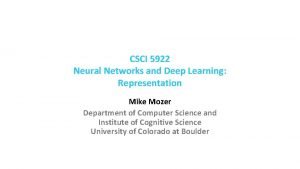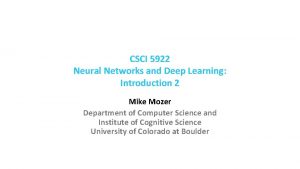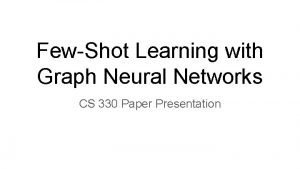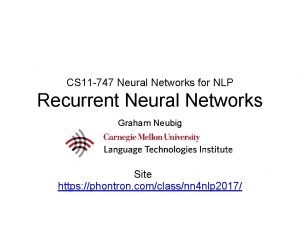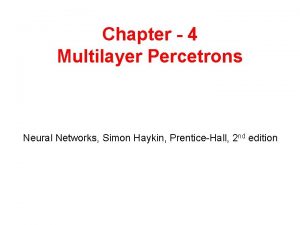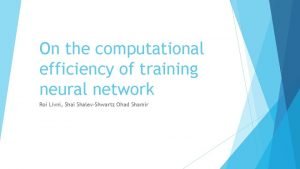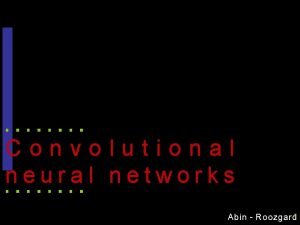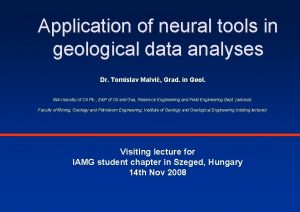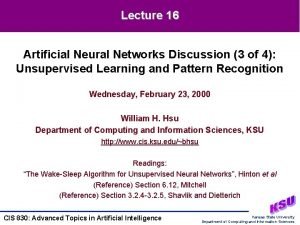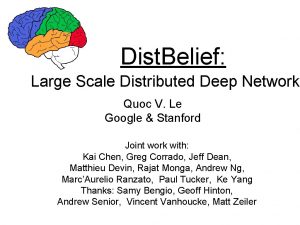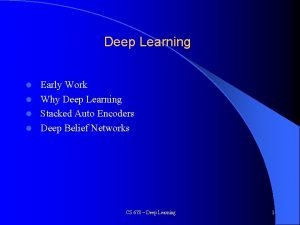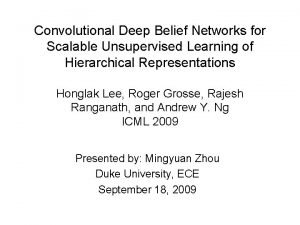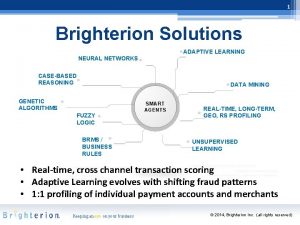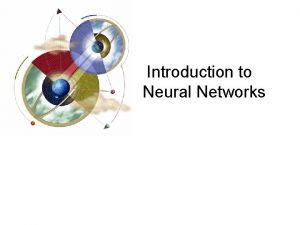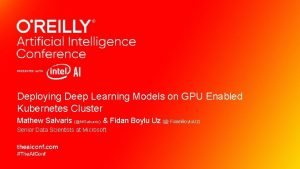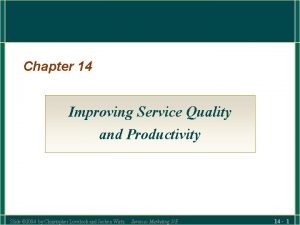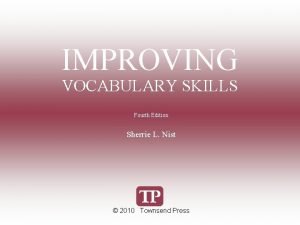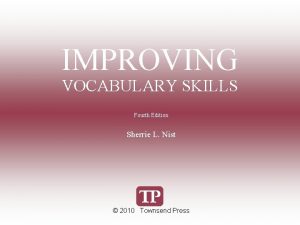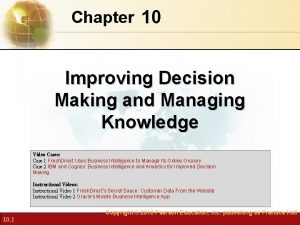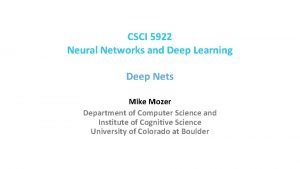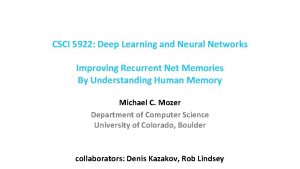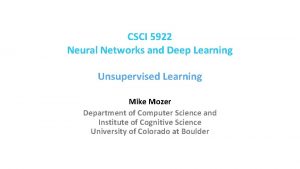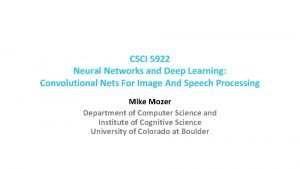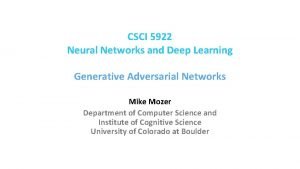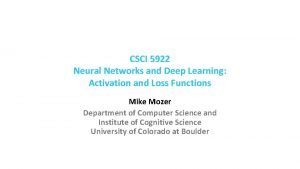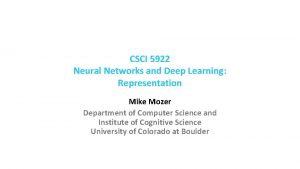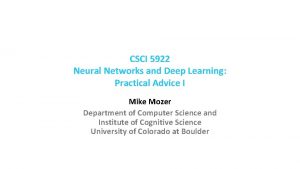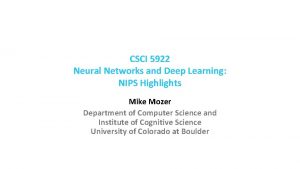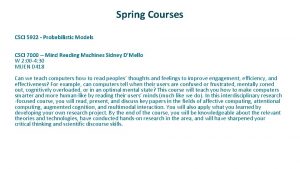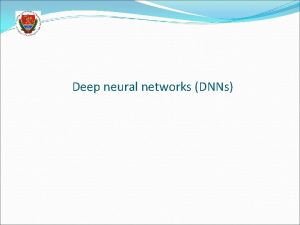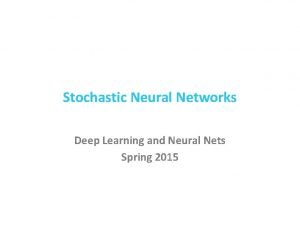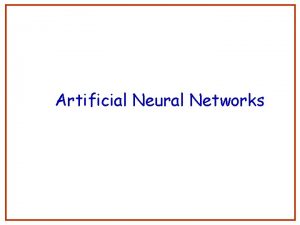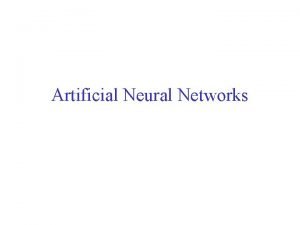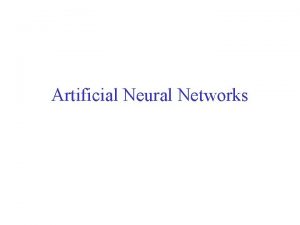CSCI 5922 Deep Learning and Neural Networks Improving
























































- Slides: 56

CSCI 5922: Deep Learning and Neural Networks Improving Recurrent Net Memories By Understanding Human Memory Michael C. Mozer Department of Computer Science University of Colorado, Boulder collaborators: Denis Kazakov, Rob Lindsey

What Is The Relevance Of Human Memory For Constructing Artificial Memories? ü ü ü The neural architecture of human vision has inspired computer vision. Perhaps the cognitive architecture of human memory can inspire the design of neural net memories. Understanding human memory essential for ML systems that predict what information will be accessible or interesting to people at any moment. § E. g. , selecting material for students to review to maximize long-term retention (Lindsey et al. , 2014)

Memory In Neural Networks Basic Recurrent Neural Net (RNN) Architecture For Sequence Processing . . . classification / prediction / translation memory sequence element GRU LSTM . . .

Declarative Memory study test Cepeda, Vul, Rohrer, Wixted, & Pashler (2008)

Forgetting Is Influenced By The Temporal Distribution Of Study Spaced study produces more robust & durable learning than Massed study

Experimental Paradigm To Study Spacing Effect study session 1 study session 2 intersession interval (ISI) test retention interval (RI)

% Recall Cepeda, Vul, Rohrer, Wixted, & Pashler (2008) Intersession Interval (Days)

Predicting The Spacing Curve characterization forgetting after of student one and session domain intersession interval Multiscale Context Model % Recall predicted recall Intersession Interval (Days)

ü Multiscale Context Model (Mozer et al. , 2009) § Neural network § Explains spacing effects ü Multiple Time Scale Model (Staddon, Chelaru, & Higa, 2002) § Cascade of leaky integrators § Explains rate-sensitive habituation ü Kording, Tenenbaum, Shadmehr (2007) § Kalman filter § Explains motor adaptation

Key Features Of All Three Models ü ü ü Each time an event occurs in the environment… A memory of this event is stored via multiple traces Traces decay exponentially at different rates fast trace strength ü medium + slow + Memory strength is weighted sum of traces Slower scales are downweighted relative to faster scales Slower scales store memory (learn) only when faster scales fail to predict event

Exponential Mixtures ü Infinite mixture of exponentials gives exactly power function ü Finite mixture of exponentials gives good approximation to power function + + = ü With , can fit arbitrary power functions

events Memory Strength Depends On Temporal History memory strength time

Predicting Student Knowledge ? time

Time Scales and Human Preferences ? time

Time Scale and Temporal Distribution of Behavior ü Critical for modeling and predicting many human activities: § Retrieving from memory § Purchasing products § Selecting music § Making restaurant reservations § Posting on web forums and social media § Gaming online § Engaging in criminal activities § Sending email and texts x 1 t 1 x 2 t 2 x 3 x 4 t 3 t 4

Recent Research Involving Temporally Situated Events ü ü ü Discretize time and use tensor factorization or RNNs § e. g. , X. Wang et al. (2016), Y Song et al. (2016), Neil et al. (2016) Hidden semi-Markov models and survival analysis § Kapoor et al. (2014, 2015) Include time tags as RNN inputs and treat as sequence processing task § Du et al. (2016) Temporal point processes § Du et al. (2015), Y. Wang et al. (2015, 2016) Our approach § incorporate time into the RNN dynamics

Temporal Point Processes ü

Hawkes Process ü Intensity depends on event history § Self excitatory § Decaying ü Intensity decays over time § Used to model earthquakes, financial transactions, crimes § Decay rate determines time scale of persistence intensity h(t) event stream Time

Earthquakes

Hawkes Process ü ü Conditional intensity function Incremental formulation with discrete updates

Hawkes Process As A Generative Model ü

Prediction ü ?

Key Premise ü

Bayesian Inference of Time Scale ü

long medium short X Intensity long medium short marginal

inferred true

Effect of Spacing

Neural Hawkes Process Memory Michael C. Mozer University of Colorado, Boulder Robert V. Lindsey Imagen Technologies Denis Kazakov University of Colorado, Boulder

Hawkes Process Memory (HPM) Unit ü

Embedding HPM in an RNN ü

Generic LSTM RNN predicted event LSTM current event A B LSTM A C LSTM B . . . LSTM C . . .

HPM RNN predicted event HPM A B HPM current event HPM A time to time predicted since last event C B . . . HPM C . . .

Reddit Postings

Reddit ü Data § 30, 733 users § 32 -1024 posts per user § 1 -50 forums § 15, 000 users for training (and validation), remainder testing ü Task § Predict forum to which user will post next, given the time of the posting

Reddit Results ü

Two Tasks ü Event prediction § Given time of occurrence, which of n event types is most likely? ü Event outcome § Given event type and time of occurrence, predict event outcome. § E. g. , if a student is prompted to apply some knowledge or recall a fact, will they succeed? • input: `student retrieved item X at time T successfully or unsuccessfully’ • output: `will student retrieve item X’ at time T’ successfully or unsuccessfully? ’

Word Learning Study (Kang et al. , 2014) ü Data § 32 human subjects § 60 Japanese-English word associations § each association tested 4 -13 times over intervals ranging from minutes to several months § 655 trials per sequence on average ü Task § Given study history up to trial t, predict accuracy (retrievable from memory or not) for next trial.

Word Learning Results ü ü ü Majority class (correct) 62. 7% Traditional Hawkes process 64. 6% Next = previous 71. 3% LSTM 77. 9% HPM 78. 3% LSTM with �� t inputs 78. 3%

Other Data Sets ü ü last. fm § 30, 000 user sequences § predict artist selection § time interval between selections varies from hours to years COLT § 300 students practicing Spanish vocabulary (~200 words) over a semester MSNBC § sequence of web page views categorized by topic (sports, news, finance, etc. ) § 10 k sequences used for training, 110 k for testing Synthetic bursty § Poisson distributed events over a finite window, with rate ~ 1/window_duration § 5 event streams

Multiple Performance Measures ü ü ü Test log likelihood Test top-1 accuracy Test AUC

Key Idea of Hawkes Process Memory ü ü ü Represent memory of (learned) events at multiple time scales simultaneously Output ‘appropriate’ time scale based on input history Should be helpful for predicting any system that has dynamics across many different time scales § including human behavior and preferences

Novelty ü The neural Hawkes process memory belongs to two classes of neural net models that are just emerging. § Models that perform dynamic parameter inference as a sequence is processed see also Fast Weights (Ba, Hinton, Mnih, Leibo, & Ionescu, 2016) and Tau Net (Nguyen & Cottrell, 1997) § Models that operate in a continuous time environment see also Phased LSTM (Neil, Pfeiffer, & Liu, 2016)

Not Giving Up… ü Hawkes process memory § input sequence determines the time scale of storage ü CT-GRU § network itself decides on time scale of storage

Continuous Time Gated Recurrent Networks Michael C. Mozer University of Colorado, Boulder Denis Kazakov University of Colorado, Boulder Robert V. Lindsey Imagen Technologies

Gated Recurrent Unit (GRU) (Chung, Ahn, & Bengio, 2016) ü

Reconceptualizing the GRU ü Storage gate (s) decides § fraction of q to store in very long term memory § remainder of q is forgotten immediately (infintessimally short term memory) ü Can think of storage gate as selecting time scale of storage of input q

Reconceptualizing the GRU ü Retrieval gate (r) decides § fraction of h to retrieve from very long term memory, versus § fraction of h to retrieve from infintessimally short term memory ü Can think of retrieval gate as selecting time scale of retrieval of memory h

Continuous Time GRU ü

GRU CT-GRU + ü ü Memory is split across time scales The signal to be stored (q) is deumultiplexed by s ü The signal to be retrieved (h) is multiplexed by r

Time Scales ü Represent a continuous span of time scales with a discrete set § Log-linear spacing of discrete set ü Represent any arbitrary scale as a mixture from discrete set § Goal: match decay half life

CT-GRU +

Working Memory Task ü Store a symbol for a certain duration § symbols: A, B, C § durations: S (1 step), M (10 steps), L (100 steps) ü Probe § Is a specified symbol currently in memory? 100 steps LA MB A? yes A? no

CT-GRU vs. GRU CT-GRU learns sharper cut off of memory CT-GRU learns to use S/M/L timescales L M S A B C S M L Storage-Retrieval Lag

Clustering Task Detect 3 events in a window of 10 steps § any order § other events interspersed Accuracy ü

ü kj

State Of The Research ü LSTM and GRU are pretty darn robust § designed for ordinal sequences, but appears to work well for event sequences ü HPM and CT-GRU work as well as LSTM and GRU but not better § They do exploit different methods of dealing with time § Explicit representation of time in HPM and CT-GRU may make them more interpretable ü Still hope for–at very least—modeling human memory
 Csci 5922
Csci 5922 Csci 5922
Csci 5922 Deep forest: towards an alternative to deep neural networks
Deep forest: towards an alternative to deep neural networks Mippers
Mippers Efficient processing of deep neural networks
Efficient processing of deep neural networks Neural networks and learning machines 3rd edition
Neural networks and learning machines 3rd edition Neural networks and learning machines
Neural networks and learning machines Few shot learning with graph neural networks
Few shot learning with graph neural networks Tony wagner's seven survival skills
Tony wagner's seven survival skills Visualizing and understanding convolutional neural networks
Visualizing and understanding convolutional neural networks Neural networks for rf and microwave design
Neural networks for rf and microwave design Neural networks and fuzzy logic
Neural networks and fuzzy logic Improving own learning and performance examples
Improving own learning and performance examples Cmu machine learning
Cmu machine learning Fat shattering dimension
Fat shattering dimension Neural pruning ib psychology
Neural pruning ib psychology Audio super resolution using neural networks
Audio super resolution using neural networks Convolutional neural networks for visual recognition
Convolutional neural networks for visual recognition Image style transfer using convolutional neural networks
Image style transfer using convolutional neural networks Stride in cnn
Stride in cnn Pixel recurrent neural networks
Pixel recurrent neural networks Toolbox neural network matlab
Toolbox neural network matlab 11-747 neural networks for nlp
11-747 neural networks for nlp Xor problem
Xor problem Sparse convolutional neural networks
Sparse convolutional neural networks On the computational efficiency of training neural networks
On the computational efficiency of training neural networks Threshold logic unit
Threshold logic unit Netinsights
Netinsights Convolutional neural networks
Convolutional neural networks Convolutional neural networks
Convolutional neural networks Neuraltools neural networks
Neuraltools neural networks Gated recurrent unit in deep learning
Gated recurrent unit in deep learning Predicting nba games using neural networks
Predicting nba games using neural networks The wake-sleep algorithm for unsupervised neural networks
The wake-sleep algorithm for unsupervised neural networks Audio super resolution
Audio super resolution Convolutional neural network alternatives
Convolutional neural network alternatives Difference between datagram and virtual circuit switching
Difference between datagram and virtual circuit switching Improving student learning one teacher at a time
Improving student learning one teacher at a time Improving student learning one teacher at a time
Improving student learning one teacher at a time Deep asleep deep asleep it lies
Deep asleep deep asleep it lies 深哉深哉耶穌的愛
深哉深哉耶穌的愛 Image super resolution using deep convolutional networks
Image super resolution using deep convolutional networks Distbelief
Distbelief Greedy layer wise training of deep networks
Greedy layer wise training of deep networks Deep convolutional networks
Deep convolutional networks Convolutional deep belief networks
Convolutional deep belief networks Basestore iptv
Basestore iptv Cuadro comparativo entre e-learning b-learning y m-learning
Cuadro comparativo entre e-learning b-learning y m-learning Adaptive learning neural network
Adaptive learning neural network Terminator 2 neural net processor
Terminator 2 neural net processor Autoencoders
Autoencoders Kubernetes gpgpu
Kubernetes gpgpu Service quality and productivity
Service quality and productivity Methods of improving quality business a level
Methods of improving quality business a level Improving vocabulary with word parts and context clues
Improving vocabulary with word parts and context clues Improving vocabulary with word parts and context clues
Improving vocabulary with word parts and context clues Improving decision making and managing knowledge
Improving decision making and managing knowledge
